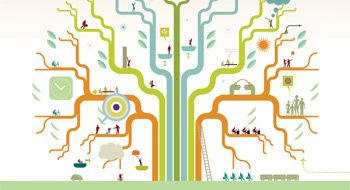

This is Part 2 of our 7th annual survey of CAP members four-part series. Read Part 1, Part 3 and Part 4.
The notion of retirement triggers a lot of stress for many Canadians. As well as doubts about whether they’ll be ready financially, half (51%) of participants in employer-sponsored retirement plans don’t feel emotionally prepared for leaving the workforce, according to the latest CAP Member Survey. Anticipated challenges range from boredom and health issues, to lifestyle adjustment and managing debt.
Considering the worries, it’s not surprising that the average expected retirement age rose to 63.2 years in 2012. What is perhaps more surprising is that the recent eligibility changes to OAS and the Guaranteed Income Supplement (GIS) haven’t driven the expected age of retirement even higher. Although three-quarters (76%) of affected plan participants claim awareness of the eligibility age rising to 67 beginning in 2023, only 39% of those between 18 and 53 years old plan to work until they reach that age. Nearly the same number (37%) plan to retire before age 67, regardless of the impact on their retirement income, and 24% say the change does not affect them. When non-participants were asked if the change to OAS/GIS eligibility increases the likelihood that they will join their employer’s DC or group RRSP within the next year, only 28% said it would.
“With the recent OAS changes, plan sponsors may need to shift from educating members about accumulation to providing more education on de-accumulation,” says Jillian Kennedy, senior associate with Mercer. “Communication needs to become more generational, with an emphasis on encouraging younger employees to build capital and save and on helping members who are getting close to retirement with retirement planning.”
Despite concerns about financial and emotional preparedness, the vast majority (93%) optimistically envision living at least somewhat independently in retirement. On average, plan participants expect to have 53.7% of their current annual income during retirement, with 30.8% of their total retirement income to come from their employer-sponsored DC plan or group RRSP, 20.7% from government plans, and 19.5% from personal RRSPs saved outside of the employer plan.
“With half [51%] of respondents identifying that they will only have 50% or more income replacement at retirement and the other half [49%] falling below a replacement rate of 50%, there are a significant number of people who may feel that retirement is a stressful event,” says Dianne Verschuere, business development manager, group retirement services, with Desjardins Financial Security. “Based on the survey results, they trust that government programs will be available when they retire, but DC plans are seen as increasingly less reliable because of the volatility of the markets. The average retirement age has increased to 65, but ‘Freedom 65’ doesn’t seem so free, and it seems there is little excitement about retirement for a large number of people.”
What happens if employees don’t have enough money to support their expected standard of living? Nearly half (45%) of plan participants say they’d retire and work part-time, with one-third saying they would continue working and postpone retirement until they had enough funds. A brave 12% would retire anyway and live at a lower standard of living.
“The trend for employees to delay retirement or to retire and take a part-time job means added costs for a plan sponsor, because, as people get older, there may be more medical costs and extra years of matching contributions to the pension plan,” says Anna Pagliuca, associate vice-president, customer experience, group savings and retirement, with Standard Life. “But there is also a great opportunity for employers to use these older individuals in their workforce planning and to mine the years of experience and knowledge to help mentor and train younger employees.”
